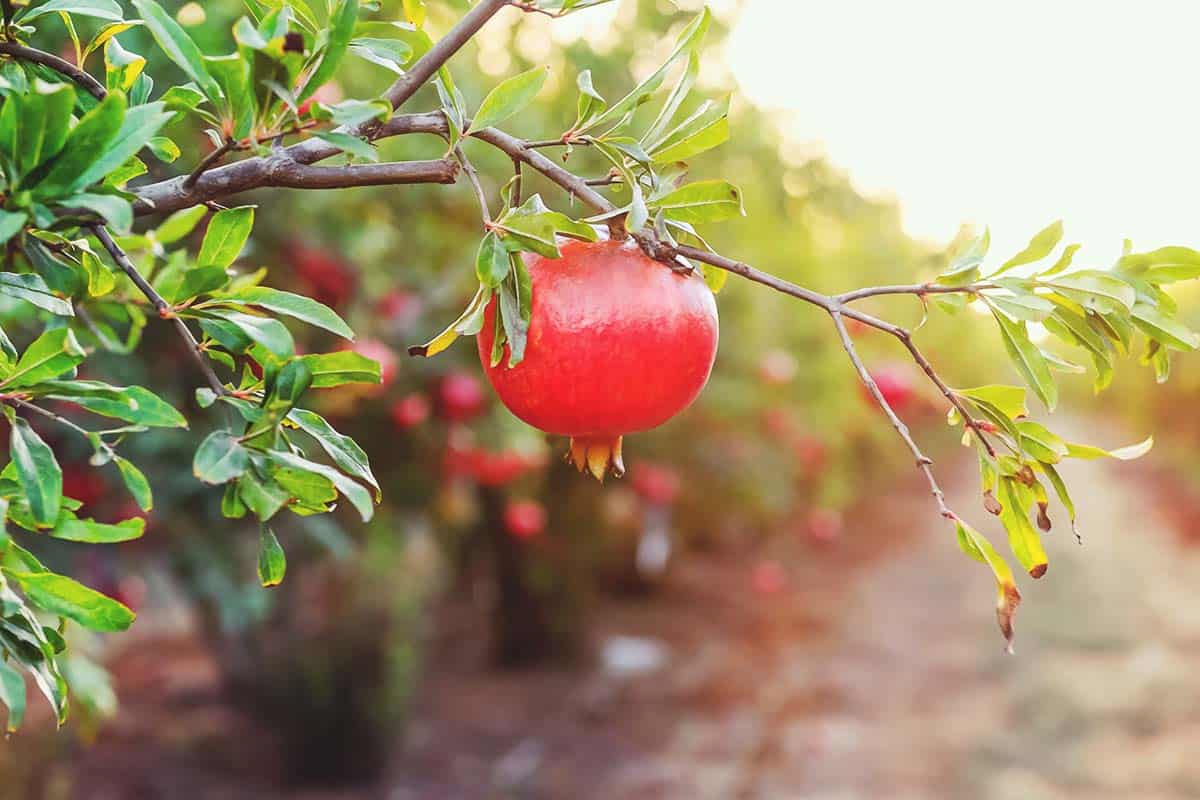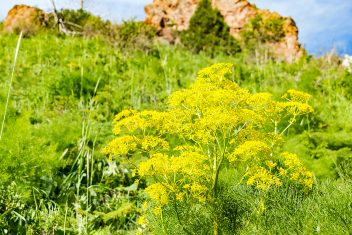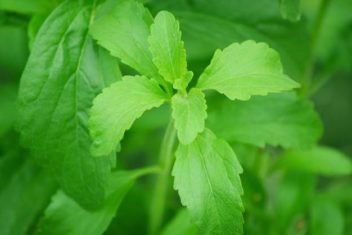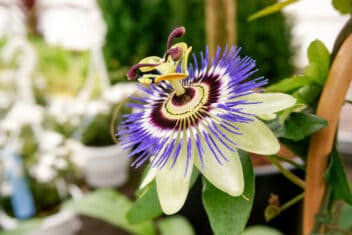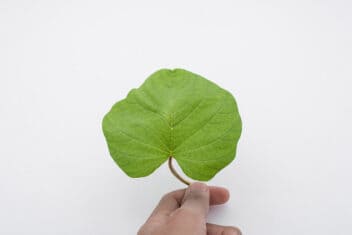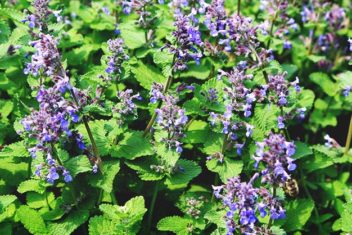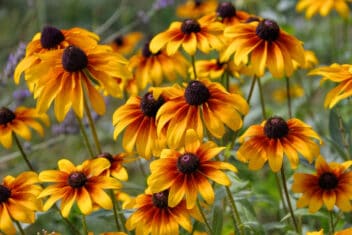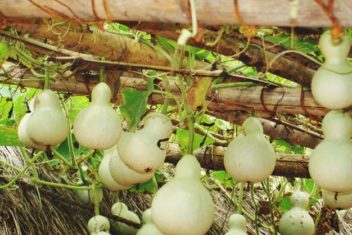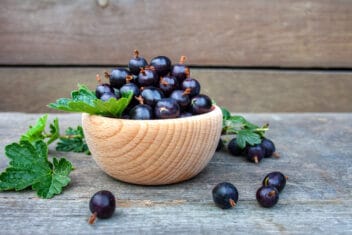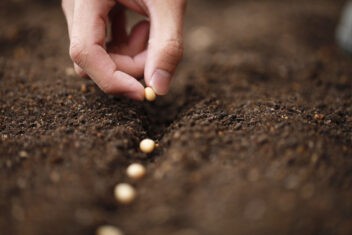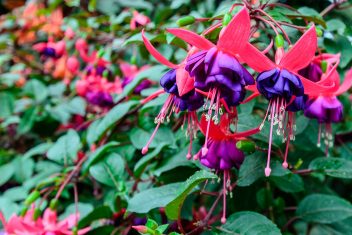Pomegranates. Just the word has my mouth watering with the thought of those juicy arils bursting in my mouth with their tart delights. For years I paid out top dollar to get my hands on the ruby fruits, but then I realized – why not try growing pomegranates myself?
Pomegranates are a delicious addition to your backyard orchard or edible landscaping. The tree has beautiful red-orange flowers that turn into decorative fruit in the fall. Inside of the fruit, you find juicy arils – the small seeds – that taste sweet and sour, and they make a delicious salad topping, juice or snack.
Not every climate can grow pomegranates, which is unfortunate because they’re so delicious. If you don’t live in the right area, don’t give up – you can try growing pomegranates in containers so that you can bring them indoors or into a greenhouse over the winter.
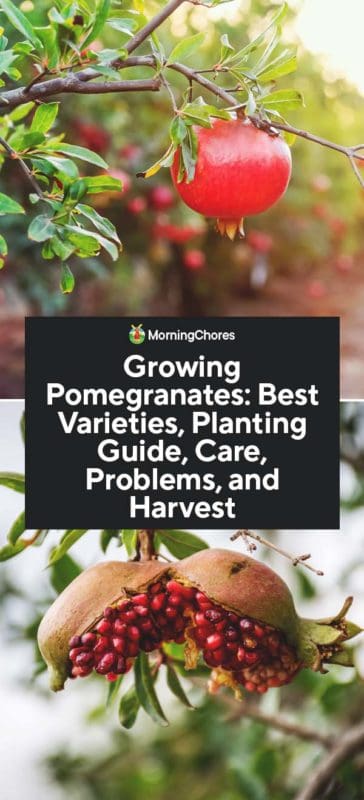
The Best Varieties of Pomegranates
Pomegranates come in many varieties and, of course, some are more popular than others. Some types of pomegranate trees bear fruit with yellowish pink skins, while others have deep burgundy skins – and everything in between. Some varieties have soft arils, while others have harder arils.
Here are the varieties that I think are worth checking out.
Sienevyi
This variety has large, soft seeded fruit that is sweet in flavor, sort of like a watermelon. It grows fruits with pink skin and dark purple arils. Sienevyi is one of the most popular pomegranate tree types.
Parfianka
Here is another soft-seeded pomegranate variety with bright red skin and pink arils. This variety is super juicy with a lovely wine flavor.
Golden Globe
If you want to try growing pomegranates on the coast, golden globe has softish arils that come from bright red or orange blossoms. They’re prolific growers over a long season.
Sin Pepe
Do you want a seedless pomegranate? If so, Sin Pepe is your choice. Not technically, seedless, this type – often known as pink ice and pink soft – is another soft-seeded variety with a flavor similar to fruit punch, with light pink arils.
Angel Red
This variety grows soft arils that are juicy, and the rinds are bright red. Angel red is a heavy producer and a great choice if you want pomegranate juice.
Kashmir Blend
This variety has medium-hard seeds with a red rind that has yellowish-green tinges. The arils are tart to sour and the fruits grow on a small-sized tree. It’s a good choice for cooking.
How to Plant Pomegranate
Growing Zones
Pomegranates do best when they grow in climates USDA hardiness zones 7-12. With a little cover, they can potentially grow down to zone 5.
Sun Requirements
Pomegranate trees need a location with full sunlight.
Soil Requirements
Pomegranates can adapt to many different types of soil, but they do best when grown in loamy soil with good drainage. You can try adding compost to your earth to help increase the drainage and add nutrients.
Aim for a pH between 5.5 and 7.2.
Growing Pomegranate Trees from Cuttings
Most of the time, you grow pomegranates from cuttings to ensure the best quality of fruit. When you plant your tree, dig a hole that is three times the size of your pot and the same depth as the root ball. Mix in aged compost or manure with the dirt you removed from the planting hole.
Remove the plant and loosen the root ball. Place the plant in the hole and replace the soil with the soil and aged compost. Gently pack down the dirt, but make sure that you don’t plant too deeply. The plant should be at a position with the topmost roots at the soil line.
After you pat down the dirt, water the tree deeply to help settle the roots and eliminate any air pockets. Make sure you don’t put any fertilizer in the planting hole.
Growing Pomegranate Trees from Seeds
You can grow pomegranates from seeds even though most people prefer to use cuttings. Here are the steps.
- Cut the pomegranate in half and remove the arils.
- Rinse the arils under cold water and remove the red pulp, leaving out the seed. Set the seeds aside to dry.
- Plant the seeds 1/4 inch deep in a seed-starting tray filled with potting soil. Make sure you only plant one seed per cell. It’s best if you plant the seeds in midwinter, with the goal that seedlings grow strong enough by the spring.
- Put the seeds in a sunny area. You can try a south-facing window or provide artificial lighting.
- Water the seeds to keep the soil moist. If it feels dry, water again and cover the tray with a clear plastic bag. It takes six weeks for pomegranate seeds to germinate.
- Slowly harden off the seedlings by taking them outside for a few hours each day as spring approaches.
Can You Grow Pomegranate Trees in Containers?
Believe it or not, you can grow pomegranate trees in containers if you pick a dwarf variety – these can grow as low as two feet high, and they do well in containers.
If you want to try growing pomegranates in containers, make sure they have a spot with plenty of sunlight. Sometimes they can tolerate partial shade, but they grow best and fruit better in sunlight.
Also, you need a 10-gallon container to hold the tree. Add one-quarter of the soil into the pot, and then set the root ball into the container. Refill the container while gently patting the dirt into place. Make sure not to cover the trunk with the soil and to water the new tree well.
Spacing
Make sure you provide plenty of space for your tree to grow unless your goal is to keep it small with intense pruning. On average, you want an area 20 feet in diameter. If you’re planting as a hedge, you can plant these trees as close as 10 feet apart.
How to Care for Pomegranates
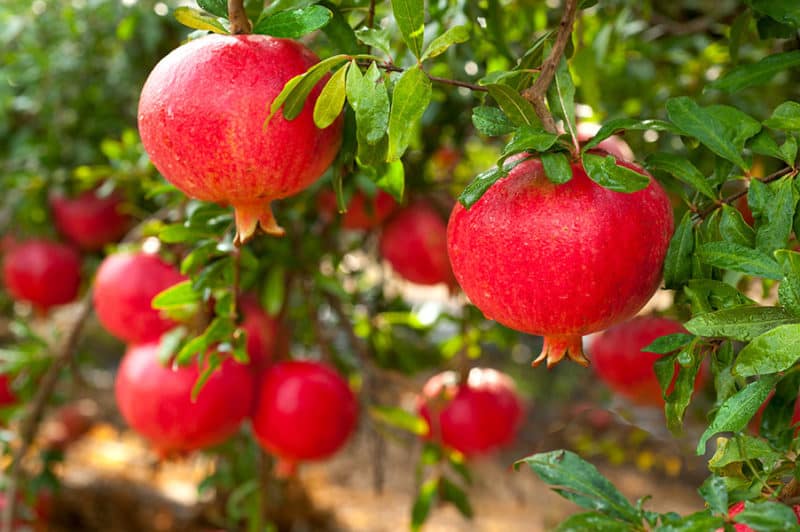
Watering
For the most part, pomegranate trees don’t have high water requirements. They can survive drought conditions for several years, but that does affect the harvest. Uneven amounts of water, either from over-irrigating or heavy summer rains can lead to fruit cracking, decreased fruit production, and other harvest problems.
In the first year, you should water twice a week for light soil or once a week for clay soil. Soak the entire root system well, which means you need to water quite deeply.
Pruning
You don’t have to prune your pomegranate trees, but it helps immensely with the harvest. Pruning encourages better fruiting and a shapelier tree. These trees naturally grow in a bush-form and produce a lot of suckers, so shaping things up helps the tree focus on growing healthy fruits.
When your tree is a year old, pick one of the six trunks to keep and prune the rest to the ground to create a tree shape. Professional arborists prefer to keep five or six trunks because it helps your tree produce fruit faster and requires less care. It also helps the tree recover quicker if it’s damaged by frost. It’s up to you which method you choose.
When you’re pruning annually after the initial shaping, prune lightly and don’t trim all the branches in the same year. The fruit grows on new shoots that come from wood that is more than one year old. Pruning all of the new growth back at once means that you’ll have nothing to harvest.
Fertilizing
Use a balanced organic fertilizer. Feed your tree in November and March each year. Whatever fertilizer you pick, make sure it contains zinc, manganese, magnesium, copper, and boron. Those are the nutrients that are vital for plant growth.
Companion Planting for Pomegranates
Pomegranates grow well with the following plants:
- Sunflower
- Cosmos
- Zinnia
- Nasturtium
- Lavender
- Coreopsis
- Comfrey
Don’t grow pomegranate near corn or potatoes.
Common Pests and Diseases of Pomegranate Trees
Luckily, pomegranates have few diseases and pests. That’s why they’re one of the easiest fruit trees to grow in your garden. Here are a few common pests and diseases that might bother your pomegranate tree.
Heart Rot
This fungal disease can cause interior fruit rotting without any external symptoms. Typically, infected fruits are lighter in weight than healthy fruits. Unfortunately, there is no known method of control of heart rot, but you can try to monitor the moisture levels at the time of flowering.
Aphids
Aphids are a common pest that likes to suck the sap from growing shoots, flowers, and young fruit. Heavy infestations could lead to stunting the growth of the tree or a weak tree that produces few fruits.
In general, the best thing to do to control aphids is to encourage their natural enemies, like lacewings, parasitic wasps, and ladybirds. You can also spray a strong jet of water to knock off the aphids from the leaves every week or so. Some severe infestations might require an insecticide – start with a regular application of neem oil and move onto the harsher stuff if necessary.
Pomegranate Fruit Borer
This pest lays butterfly eggs on the tender leaves of growing pomegranates, and after hatching, the larvae feed on the fruit by creating holes. That damages the fruit and emits a foul smell.
Make sure to remove the damaged fruits and burn them. Also, be sure to select resistant varieties. A severe infestation might require an application of insecticide.
Leafrollers
Pomegranates are also bothered by leafrollers. These pests create shelter in the leaves of plants by rolling them up in a fine web. Use the insecticide Bacillus thuringiensis to control.
Harvesting Pomegranates
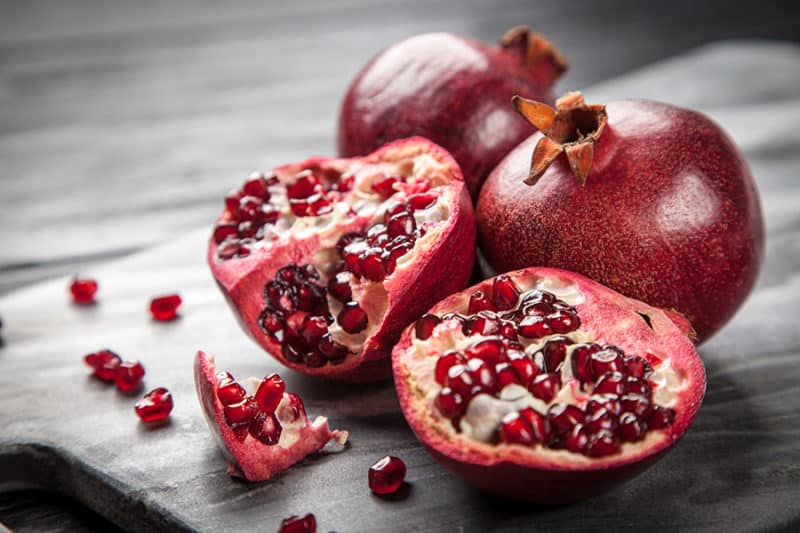
Typically, pomegranate trees can begin to fruit within a year of planting, which is quicker than most fruit trees. However, it might take a few years for the trees to produce abundantly.
Fruits can be harvested once they reach their mature skin color, feel heavy, and have a metallic sound when tapped – typically 6-7 months after flowering. If you leave the pomegranate fruits on the tree too long, they’ll split open. Pomegranates can also break open if it rains during harvest season.
The right way to harvest the fruits with pruning snips rather than pulling them from the branch. Pomegranates can be stored whole in a cool place for several weeks, or in a refrigerator for three months.
If you want to store them longer, you can de-seed them and freeze the arils whole. Another choice is to extract the juice by putting the arils through a food strainer to remove the seeds. You can freeze the juice for six months or add to canned foods. Or, why not make some preserves out of those delicious arils?
The Last Word on Growing Pomegranates
Pomegranates are undeniably delicious and packed with lots of nutrition, but that’s not the only reason to try growing them. The trees are also beautiful and you can sell your extra harvest for good money. If you live in the right climate or have the greenhouse space, try growing pomegranates in your backyard. You might be surprised how easy it is to grow these trees!
